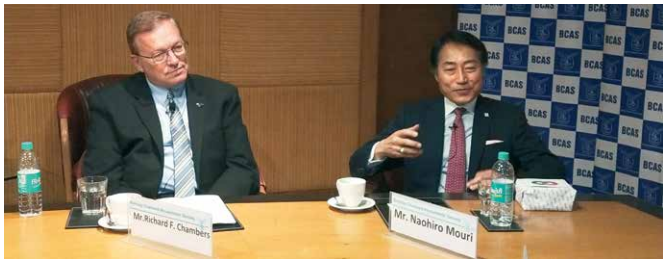PART A DECISIONS OF SUPREME COURT
- Non-governmental
organisations substantially financed by the appropriate government fall within
the ambit of ‘public authority’ under section 2(h) of the Right to Information
Act, 2005
A civil appeal was filed by D.A.V. College
Trust and Management Society and Ors. stating that it couldn’t be treated as a
public authority. A Division Bench comprising Justice Deepak Gupta and Justice
Aniruddha Bose heard the pleas filed by the appellant on 17th
September, 2019.
In the Apex Court, Hon’ble Justice Deepak
Gupta, while providing a judgement on Civil Appeal No. 9828 of 2013 stated:
‘In our view, “substantial” means a large
portion. It does not necessarily have to mean a major portion or more than 50%.
No hard and fast rule can be laid down in this regard. Substantial financing
can be both direct and indirect. To give an example, if a land in a city is
given free of cost or on heavy discount to hospitals, educational institutions
or such other body, this in itself could also be substantial financing. The
very establishment of such an institution, if it is dependent on the largesse
of the State in getting the land at a cheap price, would mean that it is
substantially financed. Merely because financial contribution of the State
comes down during the actual funding, will not by itself mean that the indirect
finance given is not to be taken into consideration. The value of the land will
have to be evaluated not only on the date of allotment but even on the date
when the question arises as to whether the said body or NGO is substantially
financed.
Whether an NGO or body is substantially
financed by the government is a question of fact which has to be determined on
the facts of each case. There may be cases where the finance is more than 50%
but still may not be called substantially financed. Supposing a small NGO which
has a total capital of Rs. 10,000 gets a grant of Rs. 5,000 from the
Government; though this grant may be 50%, it cannot be termed to be substantial
contribution. On the other hand, if a body or an NGO gets hundreds of crores of
rupees as grant but that amount is less than 50%, the same can still be termed
to be substantially financed. Another aspect for determining substantial
finance is whether the body, authority or NGO can carry on its activities
effectively without getting finance from the Government. If its functioning is
dependent on the finances of the Government then there can be no manner of
doubt that it has to be termed as substantially financed. While interpreting
the provisions of the Act and while deciding what is substantial finance one
has to keep in mind the provisions of the Act. This Act was enacted with the
purpose of bringing transparency in public dealings and probity in public life.
If NGOs or other bodies get substantial finance from the Government, we find no
reason why any citizen cannot ask for information to find out whether his / her
money which has been given to an NGO or any other body is being used for the
requisite purpose or not.’
[Civil Appeal. No. 9828 of 2013, dated 17th
September, 2019]
- Chief Justice of India’s
office under RTI Act, but conditions apply
A Constitution Bench of the Supreme Court
comprising the Chief Justice of India (CJI) Ranjan Gogoi, Justices N.V. Ramana,
D.Y. Chandrachud, Deepak Gupta and Sanjiv Khanna on 13th November,
2019 gave a judgement on
the applicability of the Right to Information (RTI) Act, 2005 to itself.
It has been hailed as a landmark judgement
by most people based on the understanding that it was only about accepting that
RTI applies to the office of the CJI. There were actually three petitions which
were decided. Subhash Chandra Agarwal had sought the information in 2007 and
2009.
Justice Chandrachud has acknowledged: ‘Failure
to bring about accountability reforms would erode trust in the courts’
impartiality, harming core judicial functions. Further, it also harms the
broader accountability function that the judiciary is entrusted with in
democratic systems including upholding citizens’ rights and sanctioning
representatives of other branches when they act in contravention of the law.
Transparency and the right to information are crucially linked to the rule of
law itself. There is a fallacy about the postulate that independence and
accountability are conflicting values.’
However, after accepting the right of citizens
to get information from the office of the CJI, the Court has ruled that the
exemption of section 8(1)(j) covers all personal information.
The Supreme Court said that confidentiality
and right to privacy have to be maintained and added that RTI can’t be used as
a tool of surveillance. It also said only names of judges recommended by the
Collegium can be disclosed, not the reasons.
The Bench, headed by the Chief Justice of
India, wrapped up the hearing saying nobody wants a ‘system of opaqueness’,
but the judiciary cannot be destroyed in the name of transparency. ‘Nobody
wants to remain in the state of darkness or keep anybody in the state of
darkness,’ it had said. ‘The question is drawing a line. In the name of
transparency, you can’t destroy the institution.’
[Civil
Appeal No.10044 of 2010 and Civil Appeal No. 2683 of 2010 dated 13th
November, 2019]
PART B RTI ACT, 2005
Suo motu, meaning ‘on its own motion’, is a Latin word used mainly as
legalese.
The basic principle
of the RTI Act is the idea that the individual national is a sovereign in her
own particular right and is the proprietor of the government. The textbook
definition of democracy is exemplified by the expression ‘for the people, of
the people and by the people’. In reality, the information provided to the
public is power given in the hands of the citizens. The most important thing
that will be looked after by this is transparency, corruption and arbitrariness
in the governance within an institution.
Certain instructions
have been drawn up by the government to make sure that the public departments /
ministries make suo motu disclosure of information. These instructions
are based on the suggestions of the Task Force set up by the government for
strengthening compliance with provisions for suo motu disclosure u/s 4
of the RTI Act, 2005. The members of civil society, Central Government
Ministries / Departments and the State Governments are prominent members of
this force.
The guidelines have
been based on the following points:
(a) Suo motu
disclosure of more details u/s 4 – This includes detailed instructions on
proactive disclosure of information related to public / private partnerships,
transfer policy and transfer orders, procurement, RTI applications received and
their responses, CAG and PAC paras, citizens’ charter and discretionary and
non-discretionary grants;
(b) Instructions
for digital publication of active disclosure of details to ensure that the
government websites disclose details completely so as to be easily available to
the citizens without any discrepancies;
(c) Detailing of
few sub-clauses of section 4(1)(b) of the RTI Act regarding publishing of
information by the public authority: ‘the procedure followed in the
decision-making process’, ‘norms set by the public authority for the discharge
of its functions’, ‘the budget allocated to each of its agency’ and ‘details in
respect of information, available to or held by it, reduced in an electronic
form’.
The compliance
mechanism for suo motu disclosure under the RTI Act includes yearly
audit of proactive disclosures made by the Ministry / Department by a third
party, examination of such audit report and offering advice / recommendation by
the Central Information Commission and inclusion of compliance details in the
annual report of the Ministry / Department.
Section 4 of the
RTI Act lays down the information which should be disclosed by public
authorities on a suo motu or proactive basis. The main aim of suo
motu disclosure is to retract all the necessary details in public domain on
a proactive basis so that the functioning of the public authorities becomes
more transparent and the need of filing individual RTI applications goes down.
Since the
promulgation of the Act in 2005, large volumes of information relating to
functioning of the government is being put in the public domain. However, the
quality and quantity of proactive disclosures are not being raised to the
desired level. There have been complaints regarding the backlog of cases in the
commissions but it is rarely accepted that mere compliance by the authorities
by providing the necessary information as mandated by the Act would result in a
steep decrease in the number of appeals filed.
It has been
observed that information seekers face problems in making use of the Act and
the officers of the public authorities face problems in implementing its
provisions. Keeping this in mind, Rajasthan has launched the Jan Soochna
portal which will display all information that ought to be voluntarily
disclosed by public authorities under the RTI Act.
The information
will be open to public scrutiny at the click of a mouse and without having to
file an RTI application. It will display issues related to 13 departments
covering around 30 government schemes. These include public distribution and
ration; farm loans; pensions; beneficiaries of Mahatma Gandhi National Rural
Employment Guarantee Act (MNREGA); food grain distribution; government-run
medical and health insurance schemes; and land extracts.
The home page of
the portal http://jansoochna.rajasthan.gov.in/ states: ‘The Government
of Rajasthan is proud to launch the Jan Soochna portal, conceptualised
in collaboration with peoples’ campaigns of Rajasthan’. This is the first
public portal of its kind in the country aimed at disclosing information on a suo
motu basis as required u/s 4(2) of the RTI Act.
The
day every state government follows Rajasthan’s example, the antagonistic
effects of the RTI Amendments, 2019 would be nullified. We appreciate and
congratulate the Rajasthan Government for this citizen-friendly venture, where
governance becomes pro-active and transparent.
PART C INFORMATION ON AND AROUND
- RTI reveals Kolhapur floods
caused by tampering with technically established flood-lines to please builders
The flood havoc in
Kolhapur and Sangli districts resulted in the deaths of 54 people and of
thousands of heads of cattle, apart from causing colossal loss to property,
farmlands and standing crops.
Was it the ferocity of nature that caused such a great calamity, or did
human interference aggravate the situation? Right to Information (RTI)
documents reveal that tampering with the red and blue line demarcation of the
Panchganga river in the Kolhapur Development Plan, due to the pressure of the
builder lobby through the Confederation of Real Estate Developers’ Associations
of India (CREDAI), to which the Chief Minister’s Office responded
affirmatively, resulted in turning 1,250 acres of flood-line area, prohibited
for any construction, into a concrete maze.
As per the RTI
documents procured from the Kolhapur Municipal Corporation, the CREDAI,
Kolhapur wrote a letter to Chief Minister Devendra Fadnavis on 9th
October, 2018 casting doubts about the Water Conservation Department’s red
flood-line report of the Panchganga, whetted by IIT, Mumbai, on new
flood-lines.
The letter claimed
that the new flood-lines may cause confusion and fear-mongering as most of the
areas under the new flood-lines fall under the residential zone and a large
number of structures have been constructed on it. They also claimed that there
is public unrest over drawing the new flood-lines. Hence, the letter urged that
the old flood-lines which were existing (which had no scientific base and were
marked haphazardly) in the Development Plan be maintained.
Further, the Water
Resources Department submitted a technical note on 5th March, 2019
to the Kolhapur Municipal Corporation. It stated that the flood level has risen
above the present blue line (shown in the Kolhapur Development Plan, which the
builders want to maintain) on ten occasions and above the present red line on
six occasions over the past 30 years. It warned that the Kolhapur Municipal
Corporation and the local administration would have to be on alert during the monsoons
if the old flood-lines are retained.
(Source:https://www.moneylife.in/article/rti-reveals-kolhapur-floods-caused-by-tampering-with-technically-established-flood-lines-to-please-builders/57983.html)
- Mumbai police hits record
high in traffic penalties, reveals RTI
The Mumbai Traffic
Police collected record fines totalling nearly Rs. 139 crores in 2018 for
violations of traffic rules, according to an RTI filing. This figure is much
higher compared to the Rs. 8.6 crores collected in 2017, said RTI activist
Jeetendra Ghadge, and the credit for this goes to the ‘e-challan’ system
implemented by the Mumbai Traffic Police in a big way.
‘This technology –
whereby an officer can simply issue an e-challan from his mobile phone – has
not only reduced corruption on the roads, but resulted in a massive collection
of fines for the government coffers,’ Ghadge told IANS.
Interestingly, the
RTI filing also revealed that the number of drunk-driving cases has
considerably decreased over the last three years. While there were 20,768 such
cases in 2016, they came down to 18,056 in 2017 and 11,711
in 2018.
Shockingly, in the
same period, the number of teenagers caught in drunk-driving cases was 1,854;
and 367 women were among those nabbed for drunk driving.
‘The figures
clearly reveal that Mumbaikars are quite an indisciplined lot while driving on
roads and even hefty fines / penalties don’t act as a deterrent. Since time is
more valuable than money for Mumbaikars, brief periods of detention (jail) or
community service, as prevalent in some advanced countries, could teach them a
lesson,’ Ghadge said.
(Source:https://www.moneylife.in/article/mumbai-police-hits-record-high-in-traffic-penalties-reveals-rti/58026.html)
- Bharat Electronics
demands fee for information on EVMs under RTI; later says it has no information
Bharat Electronics Ltd. (BEL) and Electronics Corporation of India Ltd.
(ECIL) are manufacturers of electronic voting machines (EVMs), voter-verified
paper trail (VVPAT) units and symbol loading units (SLUs) which have been under
the watchful eye of RTI activists against the backdrop of alleged tampering of
EVMs in the 2019 Lok Sabha elections.
Venkatesh Nayak,
research scholar and programme co-ordinator of the Commonwealth Human Rights
Initiative (CHRI), filed RTI applications to both the organisations, seeking
identical information.
The Central Public
Information Officer (CPIO) of BEL promptly replied in June, 2019 that
information could be supplied at a cost of Rs. 1,434 for the photocopying of
pages. However, a month later, BEL did a complete somersault stating that it
did not hold most of the information and also rejected one of the queries
(pertaining to names of engineers) stating that disclosure would endanger the
life of its engineers and even returned the bank draft that Mr. Nayak had sent
as the fee.
(Source:https://www.moneylife.in/article/bharat-electronics-demands-fee-for-info-on-evms-under-rti-later-says-it-has-no-info/58150.html)
- Frauds worth Rs. 32,000
crores rattle 18 public sector banks within three months, reveals RTI
A total of 2,480
cases of fraud involving a huge sum of Rs. 31,898.63 crores rattled 18 public
sector banks between April and June this year, an RTI query has revealed.
The country’s
largest lender, State Bank of India (SBI), remained the biggest prey to frauds
with a 38% share, Neemuch-based activist Chandrashekhar Gaur told PTI, quoting
an official of the RBI who furnished replies to his RTI application. As many as
1,197 cases of cheating involving Rs 12,012.77 crores were detected in SBI in
the first quarter.
After SBI,
Allahabad Bank faced the heat with 381 cheating cases involving Rs. 2,855.46
crores. Punjab National Bank stood third in the list with 99 fraud cases worth
Rs. 2,526.55 crores.
However, the
information provided by the RBI does not give specific details of the nature of
banking frauds and the losses suffered by banks or their customers.
(Source:https://www.indiatoday.in/business/story/frauds-worth-rs-32-000-crore-rattle-18-public-banks-within-three-months-reveals-rti-1596960-2019-09-08)
- Government spending more
on ads in Hindi newspapers: RTI
In a clear hint of
its plan to make deeper inroads into the Hindi heartland, the Narendra Modi
government has spent over Rs. 890 crores on advertising in Hindi newspapers
compared to over Rs. 719 crores in English newspapers in the last five years,
an RTI inquiry revealed.
At a time when
print media overall is facing rough weather owing to stiff competition from
digital platforms – chiefly Facebook and Google which together share 68% of
digital ads globally – Hindi and regional newspapers across the spectrum
(large, medium and small) are defying the trend and flourishing.
Leading the pack in
the period between 2014-15 and 2018-19 was Dainik Jagran which received
government advertisements worth over Rs. 100 crores in the given time-frame. Dainik
Bhaskar received advertisements worth Rs. 56.62 crores, while Hindustan garnered
advertisements worth Rs. 50.66 crores in the reported period.
Punjab Kesari was able to obtain government advertisements worth Rs. 50.66 crores
and Amar Ujala Rs. 47.4 crores.
(Source:https://www.indiatoday.in/india/story/government-spending-more-ads-hindi-newspapers-rti-1596821-2019-09-08)











